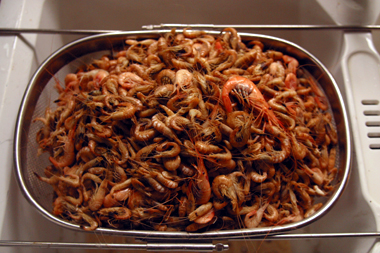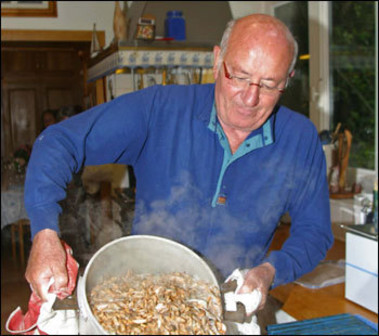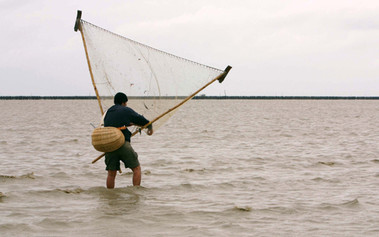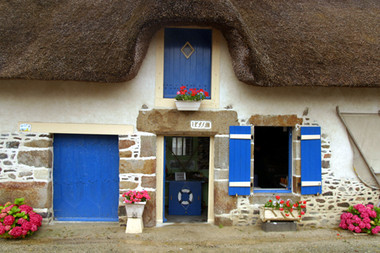Sifting an infinite sea
August 19, 2007 - The Boston Globe

CHERRUEIX—It’s a cold, clammy introduction to a centuries-old tradition.
Fishing for “les grises,” the tiny common shrimp that rarely get much bigger than a curled-up inch, in Brittany’s Bay of Mont-Saint-Michel, has gone from a tough way for Bretons to eke out a living to a pastime still passed from generation to generation.
But on this day when Jean Dugue and Georges “Jojo” Coudray share the ways of shrimping with a small group of family and friends, it’s hard to understand why they bother. It pours. It’s cold. Our hands turn white then orange, red, and finally purple.
“You don’t even feel it,” Dugue had promised on the drive that morning through the poppy-filled fields on the way to this tiny town.
 Georges Coudray has been catching and cooking these little shrimp in Brittany for decades.(Joe Ray for the Boston Globe)
Georges Coudray has been catching and cooking these little shrimp in Brittany for decades.(Joe Ray for the Boston Globe)Coudray gets a red, 1950s-era McCormick tractor left over from the Marshall Plan to sputter to life and uses it to haul our group along “roads” in the bay’s giant tidal flat. Fifteen soggy minutes later, we hop from the trailer into two inches of water and sink into three more of mud. The clever ones wear wet suits, waders, or yellow rubber raincoats with several layers underneath. I have cobbled together an outfit of shorts, swim booties with rusty zippers, a polar fleece jacket, and a cheap windbreaker.
“The bay is magnificent. Being out there gives you a feeling of liberty and independence,” says Dugue, slipping into the pleasant French habit of waxing poetic. “It’s a feeling of the infinite.”
 Ethan Arutunian, using a net called a dranet, fishes for shrimp in the Bay of Mont-Saint-Michel in Brittany. (Joe Ray for the Boston Globe)
Ethan Arutunian, using a net called a dranet, fishes for shrimp in the Bay of Mont-Saint-Michel in Brittany. (Joe Ray for the Boston Globe)“The bay is magnificent. Being out there gives you a feeling of liberty and independence,” says Dugue, slipping into the pleasant French habit of waxing poetic. “It’s a feeling of the infinite.”
Having seen the bay on nicer days, I have a sense of what he is talking about. The renowned Mont-Saint-Michel watches over it from a majestic distance, but on this day, the antique, monumental abbey comes and goes like a ghost behind the rain and fog.
“There are huge tides here—it’s like the Bay of Fundy in Canada,” says Dugue. “The bay is like a nursery for the organisms that live in it.”
Indeed, the tide rushes so far in and out of the bay that from the same spot near shore, you can have miles of water at your feet at high tide and, when it ebbs, see nothing but a vast mudflat.
“During World War II, I lived here in Cherrueix with my grandfather and he went shrimping every day. I was little, but I’d go with him,” Dugue says. “Later, when I was 12 or 13 in Saint-Malo, I’d shrimp by myself then sell it to restaurants to earn pocket money.”
“I lived all over the place,” he says, reflecting on his life, “but as soon as I came back to France, I’d go back out on the bay.”
On inclement days like this one, it also helps if your system is fortified by some of Hélène Busson’s strong coffee and Calvados, the French apple brandy that can peel layers of paint from the uninitiated. Busson is an old family friend of Dugue and his parents, and each shrimping outing begins at her home here. The “calva” Busson serves was made some 20 years ago by her now-deceased husband. “I don’t even tell my son where I keep this,” she says, leaving enough margin to keep me wondering if she’s kidding.
Despite being well on in years, Busson is still up on new shrimping rules, keeps a tide chart within arm’s reach, and makes a mean cup of coffee.
“Hélène’s husband would work the fields all day, but to make a little more money, he would run out to the flats and catch some shrimp when the tide rolled out,” says Dugue. “He’d run back to work the fields and Hélène would bicycle into the countryside to sell them. They did it twice a day. I have no idea how.”
 In his house in Cherrueix dating to 1655, Rene Bazin makes and repairs the shrimping nets known as dranets. (Joe Ray for the Boston Globe)
In his house in Cherrueix dating to 1655, Rene Bazin makes and repairs the shrimping nets known as dranets. (Joe Ray for the Boston Globe)On the flat, Ethan Arutunian, an old friend and my partner in shrimping, wades out knee-deep, drops the front end of the large X-shaped net called a “dranet” into the water, and begins pushing it along with his hips. After five minutes, he lifts it and gives a funny yelp that’s half “woohoo!” and half “eek!” A tiny, bubble-gum-pink sea ray, some fist-sized jellyfish, tiny flatfish, and a few hunks of seaweed flop from the top of the net to the bottom, but in a squiggling mass underneath it all are the shrimp—lots of them.
It’s going to be a good day.
Arutunian flips the ray and jellyfish back into the water with a nonchalance that shows his experience and I scoop everything else into a hand net, putting the larger shrimp and others known as “bouquets” into a wicker basket, tossing what’s left back into the sea.
We switch jobs and it’s surprisingly simple to figure out. It takes a moment to get the net at the right angle, learn how to push it with your hips and use your arms to steer, but there’s a Zen feeling to it and something special about the moment when you lift the net (with your back to the wind unless you want a face full of little critters). You not only see what you’ve caught, but know that you will provide for your family and friends.
You might even forget the cold and the rain.
While Dugue is the old salt of the group, Coudray is the one who keeps the tradition a living one. Once the shrimping is done and he has been back home in nearby Saint-Malo long enough for everyone to ooh and ahh over the catch, he lights a flame under a pot of water and takes a moment to reflect.
“Shrimping is a connection between the land, the sea, and the people who lived here and earned their living from it,” Coudray says.
But why make scooping tiny shrimp from muddy water in crummy weather your favorite pastime?
“I’m a sea person, I love everything that is in or on the water,” he says. Plus, Coudray reminds me that on this day, his best friend, another good buddy, his granddaughter and her boyfriend, his son-in-law, and I were out there with him, company he seemed to enjoy.
Coudray puts the shrimp into the salted water, returns it to a boil, and lets it go for just another minute. As he pours the shrimp into a strainer, a batch of the youngest of his 21 grandchildren starts clustering around his knees, waiting for him to make tiny open-faced sandwiches of fresh baguette, local butter, and the sweet, peeled shrimp.
“If I tell people about it and they sound interested, I say ‘Come with!’ “
Even his granddaughter’s suitor?
“I love it,” Coudray repeats. “She comes along and he gets to explore and learn.”
It doesn’t always work. “Some of my kids come out once and that’s all,” he says with a shrug. “Others want to come all the time.”
Sometimes, the tradition finds the people. “My father and grandfather made their livings doing this,” says René Bazin, who has made the shrimping nets since he retired 20 years ago. Now, he’s the only one in the region who makes and repairs the traditional nets.
Working from a 1655 Breton home with a thatched roof, Bazin needs about three days to make a net he’ll sell for about $190.
“You need to be retired to do this,” he jokes, watching me calculate his low wages in my head.
Bazin’s hips and knees may be giving out on him, but he is glad to have assumed his role. “Every home around here has the nets inside and the homes are always passed down from the parents to the children,” he says, “They stay in the family.”
Back with Coudray’s family in Saint-Malo, his wife, Marie-André, understands why her husband keeps the tradition going.
“It’s like in a story when the grandfather brings home the food for the family and everyone gets excited to see him when he arrives,” she says.
“It’s like a cure for him. He comes back exhausted but lighter. Now he brings his grandchildren—Anne-Claire brought her boyfriend today. It was a way for her to show him who her family is. She was proud.”
Marie-André breathes, reflects, grins, and concludes: “This is what he’s passing on to his grandchildren—this ability to share.”
Joe Ray, a former cook, is a freelance journalist and photographer based in Paris. He can be reached through his website, joe-ray.com
.
If you go…
What to do
Maison de la Baie du Mont-Saint-Michel
Port Le Vivier/Cherrueix
35960 Le-Vivier-Sur-Mer
011-33-2-99-48-84-38 (English spoken)
maison-baie.com (French only)
The Maison de la Baie du Mont-Saint-Michel-Mytiliculture et Découverte offers one- and two-hour tractor tours surrounding the area where Coudray and Dugue go shrimping. Multithemed and child-friendly walking tours run 4-7 hours. Boots or old shoes are highly advised.
Two-hour tractor tours: adults $16, children under age 12 $9, accompanied children under 6 free. Reservations only. Call ahead.
René Bazin
54 Rue du Rageul
35120 Cherrueix
011-33-2-99-48-92-22
The beautiful 1655 Breton home and studio where René Bazin makes and repairs the shrimping nets called dranets is worth a visit. If you’re lucky, Bazin might even loan you a net so you can try shrimping. Otherwise, nets cost around $192.
Where to stay
Hotel Beaufort
25 Chaussée du Sillon
35400 Saint-Malo
011-33-2-99-40-99-99
hotel-beaufort.com/index_en.html
They cost more, but the view from the rooms overlooking the sea are worth it in this simple, well-located hotel outside Saint-Malo’s city walls. Rooms $103-$199 off-season, $185-$281 high season.
Manoir du Cunningham
9 Place Monseigneur Duchesne
35400 Saint-Malo
011-33-2-99-21-33-33
A small hotel in a beautiful 17th-century building. Rooms $178-$233 in winter, $205-$260 in summer.
Where to eat, drink . . .
Galettes de Saint-Malo
6 Place de la Roulais
35400 Saint-Malo
011-33-2-99-19-72-84
Known to locals as La Roulais for the square it is on, this is the place to have a savory Breton buckwheat crepe known as a “galette.” Lunch special with a savory galette du jour and a sweet crepe $15.
Farmers’ markets of Saint-Malo
Get “les grises,” which can be found precooked at the city’s roving food markets, along with a fresh baguette and salty Breton butter, to put together a sandwich that highlights the tiny shrimp’s sweet flavor. Open every morning except Sunday 8 a.m.-1 p.m. Market locations can be found at ville-saint-malo.fr/vivre/en/the-markets.html.
L’Aviso
12 Rue du Point du Jour
35400 Saint-Malo
011-33-2-99-40-99-08
Over 300 bottled beers and 11 on tap, and simple and tasty open-faced sandwiches called “tartines” can be ordered with sausage, pâté, or cheese. Daily 5 p.m.-3 a.m. Half-pint of beer $4.80, tartines $8.
. . . and down some oysters
Though the main drag in the town of Cancale (known as French oyster mecca) can be too touristy for its own good, a cluster of open-air stands at the end of the Quai Gambetta makes it worth a trip.Prices vary by season, variety, and size, but expect to pay between $7.50 and $20 for a dozen.
See the .pdf version of this story as it ran in the Boston Globe: page 1, page 2